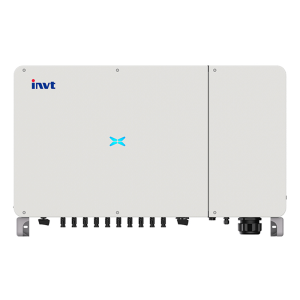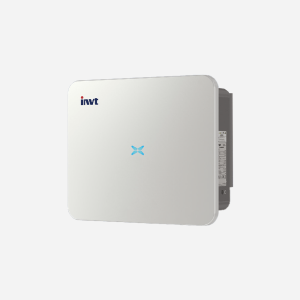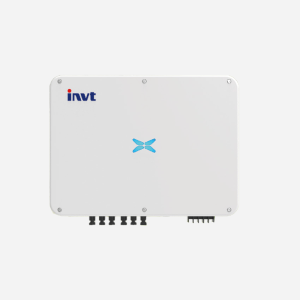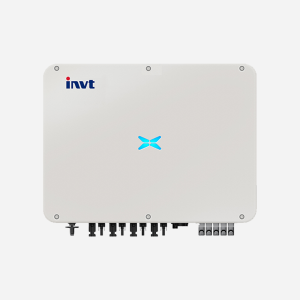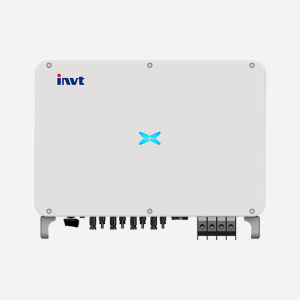On-Grid Inverters In India
An on-grid inverter, also known as a grid-tie inverter, is a type of power inverter that converts direct current (DC) electricity into alternating current (AC) electricity and feeds it into an existing electrical grid. It is an essential component in solar photovoltaic (PV) systems that are connected to the public electricity supply.
Basic Function and Purpose: The primary function of an on-grid inverter is to efficiently convert the variable DC output of the solar panels into a clean AC current that is compatible with the voltage and power quality requirements of the grid. Unlike off-grid inverters, on-grid inverters do not need to work with batteries since they are designed to send the generated electricity directly to the grid or for immediate use within the home or business.
The purpose of an on-grid inverter goes beyond mere conversion of currents. It ensures that the energy produced by solar panels can be either used to power electrical devices within the property or be fed back into the grid. When excess energy is produced, it can be sold back to the power company, often resulting in a credit to the solar system owner, a process known as net metering.
Importance in Solar Energy Systems: On-grid inverters are a critical component in solar energy systems for several reasons:
- Interfacing with the Grid: They provide the interface between the solar energy system and the electrical grid, allowing for the transfer of energy in either direction.
- Maximizing Energy Production: Many on-grid inverters come with Maximum Power Point Tracking (MPPT) technology, which maximizes the energy harvest from the solar panels by continuously adjusting the system parameters to ensure the most efficient conversion of solar energy.
- Monitoring and Management: Modern on-grid inverters often include smart features that allow for remote monitoring and management of the solar energy system’s performance, which is vital for maintenance, troubleshooting, and optimizing energy production.
- Compliance and Safety: On-grid inverters ensure that the energy fed into the grid meets specific standards for voltage, frequency, and power quality. They also include safety features like anti-islanding protection, which automatically shuts down the inverter if the grid power is lost, preventing potential harm to utility workers and equipment.
- Financial Benefits: By enabling net metering, on-grid inverters allow homeowners and businesses to receive financial credit for the surplus energy they generate, thus reducing their overall electricity costs and improving the return on investment for solar energy systems.
Operating Principles
On-grid inverters convert direct current (DC) to alternating current (AC) through a process called inversion. The DC power generated by solar panels is fed into the inverter, where it passes through a series of electronic circuits. These circuits use semiconductor devices, such as transistors or thyristors, to switch the DC input on and off rapidly in a specific pattern. This switching action creates a waveform that closely resembles AC power. The inverter’s internal filters then smooth this waveform into a pure sine wave that matches the frequency and voltage of the grid’s AC power.
Synchronization with the Utility Grid: Synchronization is a critical function of on-grid inverters. They must match the phase, frequency, and voltage of the electricity grid to safely and efficiently feed the converted AC power into the grid. This is achieved through a control circuit within the inverter that monitors the grid’s AC waveform and adjusts the inverter’s output to align with it precisely. If there is any discrepancy in frequency or phase, the inverter will not feed power into the grid. This synchronization ensures that the energy produced by the solar panels can be used by the grid without causing any disturbances or inefficiencies.
Power Optimization Techniques: On-grid inverters employ various power optimization techniques to maximize the efficiency of the solar power system:
- Maximum Power Point Tracking (MPPT):
- MPPT is a feature that allows the inverter to adjust the electrical operating point of the solar panels to ensure they produce the maximum power possible given the current light conditions. Since the optimal point varies with temperature and the amount of sunlight, MPPT is a dynamic process that continuously seeks this point throughout the day.
- Reactive Power Control:
- Some advanced on-grid inverters can manage reactive power, which helps to maintain the voltage levels on the grid within the required range. This is important for the stability of the grid, especially when there are high levels of solar penetration.
- Anti-Islanding Protection:
- While not a power optimization technique per se, anti-islanding is a safety mechanism that ensures the inverter shuts down its AC output to the grid if the grid power is lost. This feature is essential for the safety of utility workers who might be repairing the grid.
- Energy Management Systems:
- Many on-grid inverters can be integrated with energy management systems that optimize when and how much solar power is used, stored, or fed into the grid based on real-time energy consumption patterns, electricity rates, and other factors.
By employing these operating principles, on-grid inverters play a crucial role in ensuring that solar power systems operate at peak efficiency, safely integrate with the utility grid, and contribute to the overall reliability and sustainability of the power system.
Key Features
- MPPT is a sophisticated algorithm included in on-grid inverters that ensures the solar panels are operating at their optimal power output level. As environmental conditions change throughout the day, the MPPT adjusts the electrical operating points of the panels to maximize efficiency. This feature is crucial because it can significantly increase the system’s overall energy production, especially in variable weather conditions.
Efficiency Ratings:
- The efficiency rating of an on-grid inverter indicates the percentage of DC power that is successfully converted into usable AC power. High-quality inverters typically have efficiency ratings of 95% or above, meaning that only a small fraction of the solar energy is lost during the conversion process. The higher the efficiency rating, the more cost-effective and productive the solar power system is.
Grid-Tie Capabilities:
- Grid-tie capability refers to the inverter’s ability to connect and feed power into the utility grid. This feature includes the ability to synchronize the inverter’s output with the grid’s AC power in terms of voltage, frequency, and phase. It also enables homeowners to take advantage of net metering, where excess energy produced can be sold back to the grid, often resulting in a credit on utility bills.
Communication Features (Monitoring and Reporting):
- Modern on-grid inverters come equipped with various communication features that allow for the remote monitoring and reporting of the system’s performance. These features can include Wi-Fi or Ethernet connectivity, allowing the system owner or maintenance personnel to track energy production, identify issues, and assess the system’s health through a smartphone app or web portal. This real-time data is invaluable for maximizing system uptime and efficiency.
Safety Features (Anti-Islanding Protection):
- Anti-islanding protection is a critical safety feature that prevents the inverter from continuing to feed power into the grid when the grid power is down. This is essential for the safety of utility workers who may be working on the power lines, assuming the lines are de-energized. The inverter detects the loss of grid power and shuts down its output within milliseconds, ensuring no accidental back feeding of power occurs.
These key features collectively ensure that on-grid inverters not only efficiently convert and feed solar power into the electrical grid but also do so safely and with a high degree of control and monitoring. They are essential for the effective and responsible integration of solar energy into the existing power infrastructure.
Installation and Integration
- Site Assessment:
- Before installation, a thorough site assessment is conducted to determine the best location for the inverter based on proximity to the solar panels and connection to the grid.
- Mounting the Inverter:
- The inverter is typically mounted on a wall or a secure structure, considering factors like ventilation, shading, and accessibility. It should be in a location that is protected from the elements and within the temperature range specified by the manufacturer.
- Electrical Wiring:
- Professional electricians run DC wiring from the solar panels to the inverter and AC wiring from the inverter to the property’s electrical panel. Proper gauge wiring is used to handle the expected current, and all connections are made following electrical safety standards.
- Grounding:
- The inverter and the entire solar PV system must be properly grounded to protect against electrical surges and lightning strikes.
- Grid Connection:
- The inverter is connected to the utility grid through the property’s main electrical panel. This often requires a new breaker that is dedicated to the solar system.
- Commissioning:
- Once installed, the system is tested and commissioned. This includes verifying that the inverter is properly synchronized with the grid and that all safety features are functioning correctly.
Integration with Solar Panels and the Utility Grid:
- The inverter is the central hub that connects the solar panels (DC source) to the utility grid (AC destination). It must handle the variable input from the solar panels and convert it into a stable output that mirrors the grid’s AC power in terms of voltage, frequency, and phase. This integration is critical for the functionality of net metering, where excess energy can be fed back into the grid.
Compliance with Local Electrical Codes:
- Compliance with local electrical codes is non-negotiable for the safe and legal operation of an on-grid inverter. These codes may include:
- National Electric Code (NEC): In the United States, for example, the installation must comply with the NEC, which sets the benchmark for safe electrical design, installation, and inspection.
- Permitting and Inspections: Most localities require permits for the installation of solar power systems, and the work must be inspected by a certified electrical inspector to ensure compliance.
- Utility Requirements: Utilities may have their own set of requirements and standards that must be met for the system to be connected to the grid.
- Interconnection Agreements: There must be an agreement in place with the utility company that outlines the terms and conditions under which the solar system will be connected to the grid.
Adhering to these codes and requirements is essential for the safety of the installation and the reliability of the power system. It also ensures that the system owner can legally and effectively utilize the benefits of solar energy, such as financial incentives and net metering.
Benefits of Using On-Grid Inverters
- On-grid inverters enable homeowners and businesses to significantly reduce their electricity bills through a system called net metering. This system allows solar energy producers to feed excess power generated by their solar panels into the utility grid in exchange for credits. When the solar panels produce more electricity than is consumed on-site, the surplus is sent to the grid, and the electricity meter effectively runs backward, providing a credit against the electricity that is consumed at night or during periods when the panels produce less electricity. This can lead to substantial savings and, in some cases, completely offset the electricity costs.
Contribution to a Sustainable Energy Solution:
- By converting solar energy into usable power for homes and businesses, on-grid inverters play a pivotal role in promoting sustainable energy solutions. Solar power is a clean, renewable resource that reduces dependence on fossil fuels, which are finite and contribute to environmental issues such as climate change and air pollution. By facilitating the use of solar energy, on-grid inverters help to decrease greenhouse gas emissions and the carbon footprint of electricity consumption, contributing to a healthier environment and a more sustainable future.
Reliability and Maintenance:
- On-grid inverters are generally reliable components of solar energy systems. They are designed to operate for many years with minimal maintenance. Most modern inverters have no moving parts, which reduces the likelihood of mechanical failure. Additionally, they often come with monitoring systems that alert owners to any performance issues, allowing for proactive maintenance and service. This reliability ensures a steady production of electricity and contributes to the overall low maintenance costs of solar PV systems.
In summary, on-grid inverters are not just essential for the conversion of solar energy; they also offer financial benefits through net metering, contribute to the adoption of clean energy, and are designed to be a reliable and low-maintenance component of the solar energy system. These benefits make on-grid inverters a smart investment for those looking to reduce their energy costs and environmental impact.
Conclusion
On-grid inverters are a cornerstone technology in the realm of solar energy, serving as the critical interface between the photovoltaic (PV) panels and the electrical grid. Their primary role is to convert the direct current (DC) generated by solar panels into the alternating current (AC) used by household appliances and the grid at large. This conversion is not just a simple translation of energy forms; it involves sophisticated synchronization to ensure that the solar-generated electricity is in harmony with the grid’s standards.

